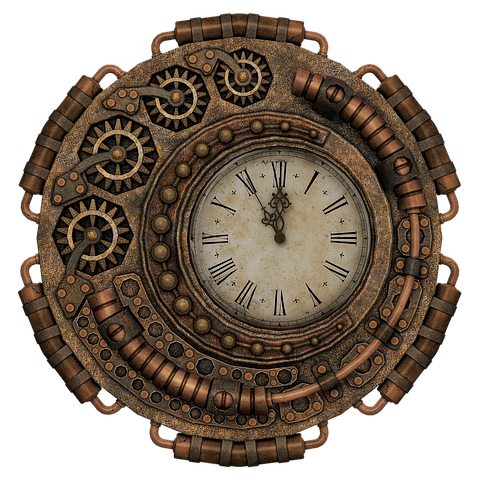Clockwork
Overview
The earliest known form of machinery was rudimentary clockwork, taught to mortals by the Lawbearer in a time before the Dawn War. A sand counterweight would slowly turn a series of gears, before ringing a bell. Automating the turning of hourglasses advanced into mechanical sun-dials, which in turn became the first clocks. Throughout history, clockwork has symbolised the repeating cycles of iteration that inevitably drive the marching of progress.Celestial Orreries "Myosa, Mydria, Ocusa; Pupil, Iris, and Sclera. Ye who behold the darkest eclipse; are beholden in turn." Orreries are celestial models, able to track and predict movements of the planet, moons, sun, and stars.
They have their origins in rotating star-charts, which have to be manually turned throughout the year.
Using a complex series of gears, they rotate celestial bodies at the same ratio as their real counterparts. The smallest are wind-up table ornaments, loosely mimicking the movement of Apocrypha and its moons.
Largest is the Zangbe Celestorium, which accurately displays the known cosmos across a domed ceiling.
It accomplishes this through a combination of intricate clockwork, and illusion magic to project the sky.
Clocks & Watches "Erathis forgive me, for clockwork is a truly wonderous gift... but the incessant ticking is insufferable." The namesake for clockwork, these timepieces are devices to accurately measure the passage of time.
The earliest timekeepers were invented during the Illumination, and have gradually improved since.
Clocks are popular among the Artisans' Assembly, while Watches are sold at Merchants' Guild offices. Though clocks have been common for some time; watches' proliferation truly began with the 5th Era.
Ownership is common in cities, with prominent worship of deities like the Lawbearer and Allhammer.
Rural denizens will more likely use a clocktower - usually atop a temple or their local Watchpost Tower.
Lighthouses "Rumour is that the Syndicate blackmails lighthouse keepers, into sending signals for their ships." Dotting the shores of Apocrypha, lighthouses are instrumental to aiding modern coastline navigation.
Evolving from pre-historic signal-tower pyres, ruins of the first lighthouses have been dated to 2nd Era.
The oldest are on the Seven Kingdoms' peninsula; having the highest density of lighthouses to this day. Some believe their invention was a direct response to the Apocryphal Flooding, at the end of the 1st Era.
Rotating, shuttered lenses make the light visible at all angles, yet more clearly at farther distances.
The ability to spot headland in fog may have proved invaluable, particularly to ship-bound refugees.
Telescopes "If I told you what's on the moons, you wouldn't believe me. That's why I'm keeping it a secret." Telescopes are cylindrical devices, using a series glass magnifying lenses for long-distance vision.
They arose from improved spyglasses, with some rudimentary forms dated back to the Illumination.
Spyglasses and simple telescopes can usually be purchased by members of the Wayfinders' Union. Screw-mechanisms used to focus inside spyglasses became automated with the advent of clockwork.
Small telescopes are only several feet long, typically mounted on tripods and compactable for carrying.
The Zangbe Celestorium owns the largest telescope, though it is located in a remote part of Asa-hiir.
Phonographs "Hello, is this thing on? It is? Great, now I need to reset the cylinder. Okay - attempt No. 4." Phonographs are technological marvels - devices capable of recording and replaying real sounds.
Incredibly recent in their development, the first schematics were published about two decades ago.
Most often they are only prototypical, with functional models as curiosities for wealthy collectors. The inventor's name is Dewdrop Honeyglow, a young Artisan's Assembly artificer from Dwar-Greyhral.
She claims she found inspiration after seeing someone use a hearing horn to listen to a music box.
Wax cylinders were conceived as an alternative to note sheets, using needles that respond to sound.
Wind-up Toys "Every night, she falls asleep listening to the music box. It's always the same song... like clockwork." Aside from clocks and watches, wind-up toys are the most common form of clockwork on Apocrypha.
They are attributed to ancient Rock-Gnomes - worshippers of the artificer demigod, Garl Glittergold.
Produced en-masse in Dwar-Greyhral, toys and music boxes can be found inside homes worldwide. Toys come in a variety of types, from moving animals, to jack-in-the-boxes, and animated landscapes.
Music boxes play songs on a miniature kalimba, either pre-programmed, or by 'reading' note sheets.
Some taverns have enchanted music boxes, which can replicate the sounds of multiple instruments.










Comments